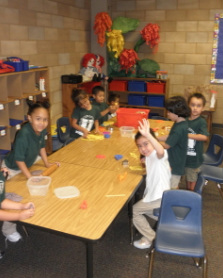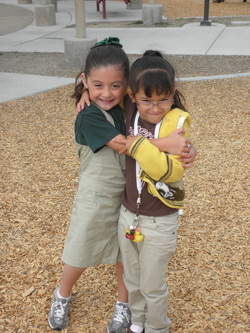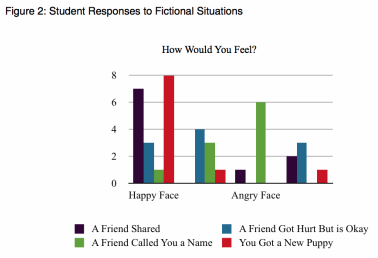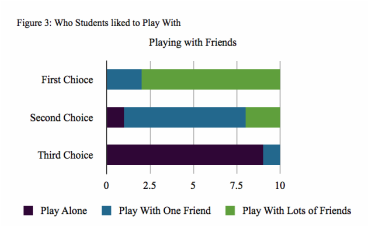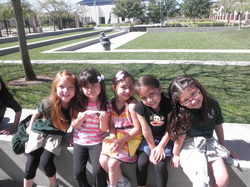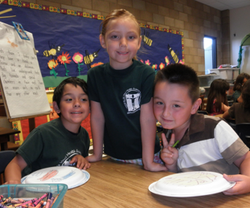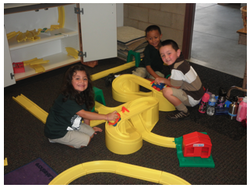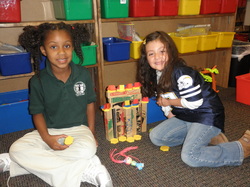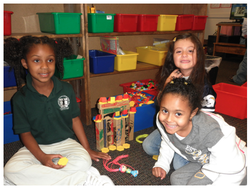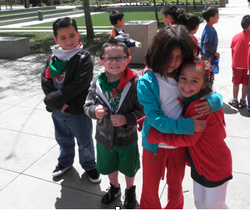Findings
The core of my research has been to create a peaceful community. I wanted my students to get along and be friends. As a teacher, my goal was to bring peace into a world of over-stimulation and chaos. I hoped to provide a supportive, loving environment that was safe and create a place where students were able express themselves without fear of humiliation or persecution. I truly believed that this was possible to do in a classroom of kindergartners. I felt that solving conflicts would come with the development of social skills. They needed to know themselves, work well with others and communicate appropriately. It is incredibly important for all people to do these things. Getting young children to value them proved to be a challenging but rewarding task. As the year progressed, my students expanded their abilities to identify their feelings, cooperate with others, and use the appropriate language to enhance our peaceful community. They also came to use their communication and cooperation skills more naturally.
It was my hope that with this foundation I would help shape life-long, successful human beings. There is not a job in the world that there is absolutely zero human interaction. I wanted my students to work well together in my classroom and work well with others for the rest of their lives. When collaborating, it is natural to have disagreements. However, having the power to resolve these conflicts in a positive and peaceful way is crucial for the success of all involved parties. I gave my students the opportunity to learn how to use and value conflict resolution skills at a young age. I hope that these skills will have a lasting impression on them.
And So It Begins
I arrived at school in August excited and refreshed. I had an entire summer to re-energize, and re-evaluate my goals as a teacher. I couldn’t wait to start a new school year with a new group of eager four and five year olds. I can’t begin to explain the feeling I get right before school starts. There are waves of excitement, anxiety, fear, happiness, disappointment, and anticipation. Sometimes these emotions happen all at once. This year was no different. I couldn’t wait for the first day of school. I had taken all summer to prepare for this school year because this year was going to be different. This was the year that I was going to be putting Action Research (AR) into my everyday life as a teacher. Just the sheer thought of this was overwhelming but at the same time I was giddy with anticipation.
Kindergarten is all about building relationships with the families. It is so important to have a strong home-school connection and my way of ensuring this was to have parent-teacher conferences in the first month of school. I had families sign up for an hour time session with me. We discussed the expectations for the school year, I answered lingering questions, and conducted student baseline assessments. Parents were exposed to the “behind the scenes” teacher process. The academic areas I assessed were: letter names, letter sounds, phonemic awareness, book sense, number sense, counting, patterning, sorting, sequencing, and self awareness. I was able to get a wonderful academic and personal picture of my students as well as inform each of my students’ families about my Action Research Project.
I found that over-all, my students were coming into kindergarten academically ready. They had a great foundation and were able to demonstrate their skills with excellent proficiency. However, it was difficult to tell how self-aware and reflective they were. I needed more time to see how they interacted with their peers. At five years old, most children are just moving from a “play next to” to a “play with” state. My students seemed to be at a developmentally appropriate place.
It was my hope that with this foundation I would help shape life-long, successful human beings. There is not a job in the world that there is absolutely zero human interaction. I wanted my students to work well together in my classroom and work well with others for the rest of their lives. When collaborating, it is natural to have disagreements. However, having the power to resolve these conflicts in a positive and peaceful way is crucial for the success of all involved parties. I gave my students the opportunity to learn how to use and value conflict resolution skills at a young age. I hope that these skills will have a lasting impression on them.
And So It Begins
I arrived at school in August excited and refreshed. I had an entire summer to re-energize, and re-evaluate my goals as a teacher. I couldn’t wait to start a new school year with a new group of eager four and five year olds. I can’t begin to explain the feeling I get right before school starts. There are waves of excitement, anxiety, fear, happiness, disappointment, and anticipation. Sometimes these emotions happen all at once. This year was no different. I couldn’t wait for the first day of school. I had taken all summer to prepare for this school year because this year was going to be different. This was the year that I was going to be putting Action Research (AR) into my everyday life as a teacher. Just the sheer thought of this was overwhelming but at the same time I was giddy with anticipation.
Kindergarten is all about building relationships with the families. It is so important to have a strong home-school connection and my way of ensuring this was to have parent-teacher conferences in the first month of school. I had families sign up for an hour time session with me. We discussed the expectations for the school year, I answered lingering questions, and conducted student baseline assessments. Parents were exposed to the “behind the scenes” teacher process. The academic areas I assessed were: letter names, letter sounds, phonemic awareness, book sense, number sense, counting, patterning, sorting, sequencing, and self awareness. I was able to get a wonderful academic and personal picture of my students as well as inform each of my students’ families about my Action Research Project.
I found that over-all, my students were coming into kindergarten academically ready. They had a great foundation and were able to demonstrate their skills with excellent proficiency. However, it was difficult to tell how self-aware and reflective they were. I needed more time to see how they interacted with their peers. At five years old, most children are just moving from a “play next to” to a “play with” state. My students seemed to be at a developmentally appropriate place.
I found the bonds that I was able to make with each of my students‘ families during the parent-teacher conferences helped immensely during the action research process. It was at these initial parent-teacher conferences that I presented each family with an overview of my Action Research Project and let them take the permission slip home to review. I was fortunate that all of my students‘ parents returned the permission slips and agreed to participate. I was ready to get started. Everyone was on board and excited about what my work would mean for their children. I was able to be open with my families and let them know what was happening every step of the way. We had a trusting relationship and it made communication easy.
Getting Acquainted
Every teacher spends the first week of school doing many different “Getting-To-Know-You” activities. I was no different. I wanted to see who my students were. What was the overall vibe of the group? How did they mesh together? I needed to know which students pushed the boundaries? Which students were shy? Who were my tattlers? Were there already students that were able to share and take turns? What was the level of English proficiency? Did some students already know one another? Who had siblings? What were their ages (actual and developmental)? How did they feel about and approach conflicts with others? For the first week of school I took copious notes about the behaviors that I saw. I wanted to get as much information about each student as I possibly could.
Getting Acquainted
Every teacher spends the first week of school doing many different “Getting-To-Know-You” activities. I was no different. I wanted to see who my students were. What was the overall vibe of the group? How did they mesh together? I needed to know which students pushed the boundaries? Which students were shy? Who were my tattlers? Were there already students that were able to share and take turns? What was the level of English proficiency? Did some students already know one another? Who had siblings? What were their ages (actual and developmental)? How did they feel about and approach conflicts with others? For the first week of school I took copious notes about the behaviors that I saw. I wanted to get as much information about each student as I possibly could.
During the first nine weeks of school, we were on a half-day schedule, meaning my students went home at 12:30 p.m. This became my first obstacle. I wanted time with my students. The time to get to know them and how they interacted with their peers and the time to observe and ask them questions. With my limited hours I found it challenging to get as much information as I wanted, as quickly as I was hoping to get it. The process took longer than I expected but I started to get a real picture of who my students were. Initially, I thought I would choose Focus Students but it turned out that I would include everyone. I felt it would be more interesting and meaningful for me to keep track of all the students and their progress. I gave an initial survey (See Appendix E) to each student to see how he or she felt in certain situations with their peers.
The data that I gathered from this initial survey was very telling. I found that for the most part students related a fictional situation with an appropriate feeling. Where they struggled was explaining why they picked that emotion. They couldn’t verbalize why they felt sad, happy, excited, or scared; they just knew that they did. This information told me that they knew what the different feelings were and that they had been situations where they experienced each of those feelings. Their knowledge was surface level. By the end of our journey I hoped they would have a better understanding and a deeper knowledge of the meaning of each emotion.
The data that I gathered from this initial survey was very telling. I found that for the most part students related a fictional situation with an appropriate feeling. Where they struggled was explaining why they picked that emotion. They couldn’t verbalize why they felt sad, happy, excited, or scared; they just knew that they did. This information told me that they knew what the different feelings were and that they had been situations where they experienced each of those feelings. Their knowledge was surface level. By the end of our journey I hoped they would have a better understanding and a deeper knowledge of the meaning of each emotion.
I also wanted to see if students would rather play alone, with one friend, or with lots of friends. They ranked their choices 1 being their preference, 2 their second choice, and 3 their least favorite option. This showed me that most students liked to play with lots of friends and most did not like to play by themselves.
Identifying an Effective Solution
“Ms. Olson we solved a conflict!” -Adrian
When kids are learning how to solve conflicts there are obviously going to be ups and downs along the way. My goal was to have all of my students be able to identify when conflicts happen and then independently decide what should they do to resolve it.
One day during our Stations (seat work time) students were doing a Letter Sort activity. They had to cut out pictures and sort those pictures into two columns: words that start with the letter s and words that start with the letter m. Then they had to glue the pictures onto a colored piece of paper. There were several colors to choose from. Each small group rotated through all three Stations. When Philip and Chance’s group got to the table there were only a few different colors left. Everyone in their group sat down and started cutting out the pictures, except them. They both reached into the tray and grabbed the last blue paper. Chance grabbed it and took off running around the table so Philip couldn’t take it away from him. Since Philip really wanted the blue paper he chased Chance trying to grab it from Chance’s hand. I stopped the boys and had them explain to me what had happened. The three of us sat down on the carpet together to see what could be done about this situation. I let both of the boys have a turn to speak and when they were finished we talked about ways to solve the problem. I gave them three different options they could use in this situation:
1. Be a nice person and let the other have it.
2. Both pick a different color.
3. Do paper, rock, scissors.
I told them you may not always get your way but we still have to work together to be united community. In the end, Chance and Philip would not be happy unless they got the blue paper. Neither was willing compromise in this situation. They both continued to insist that they get the blue paper. Since there was only one blue paper left, Philip and Chance each had to pick a different color to use. They were both upset but moved on and completed their work.
Philip and Chance were not ready to solve a conflict independently. They would need a lot more practice. Good thing that this was only the beginning of the year. I hoped that I would start to see my students working out problems independently. But I understood that would come with time and practice.
To teach students how to identify a conflict I read stories that included a conflict between the characters. As a class, we used the following questions to guide our discussions:
· Who was involved?
· What were the feelings of the characters before, during, and after the conflict?
· What caused the conflict?
· Could the conflict have been avoided?
· If so, how?
· How was the conflict resolved?
· What were the steps taken?
“Ms. Olson we solved a conflict!” -Adrian
When kids are learning how to solve conflicts there are obviously going to be ups and downs along the way. My goal was to have all of my students be able to identify when conflicts happen and then independently decide what should they do to resolve it.
One day during our Stations (seat work time) students were doing a Letter Sort activity. They had to cut out pictures and sort those pictures into two columns: words that start with the letter s and words that start with the letter m. Then they had to glue the pictures onto a colored piece of paper. There were several colors to choose from. Each small group rotated through all three Stations. When Philip and Chance’s group got to the table there were only a few different colors left. Everyone in their group sat down and started cutting out the pictures, except them. They both reached into the tray and grabbed the last blue paper. Chance grabbed it and took off running around the table so Philip couldn’t take it away from him. Since Philip really wanted the blue paper he chased Chance trying to grab it from Chance’s hand. I stopped the boys and had them explain to me what had happened. The three of us sat down on the carpet together to see what could be done about this situation. I let both of the boys have a turn to speak and when they were finished we talked about ways to solve the problem. I gave them three different options they could use in this situation:
1. Be a nice person and let the other have it.
2. Both pick a different color.
3. Do paper, rock, scissors.
I told them you may not always get your way but we still have to work together to be united community. In the end, Chance and Philip would not be happy unless they got the blue paper. Neither was willing compromise in this situation. They both continued to insist that they get the blue paper. Since there was only one blue paper left, Philip and Chance each had to pick a different color to use. They were both upset but moved on and completed their work.
Philip and Chance were not ready to solve a conflict independently. They would need a lot more practice. Good thing that this was only the beginning of the year. I hoped that I would start to see my students working out problems independently. But I understood that would come with time and practice.
To teach students how to identify a conflict I read stories that included a conflict between the characters. As a class, we used the following questions to guide our discussions:
· Who was involved?
· What were the feelings of the characters before, during, and after the conflict?
· What caused the conflict?
· Could the conflict have been avoided?
· If so, how?
· How was the conflict resolved?
· What were the steps taken?
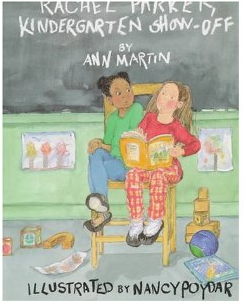
One of my favorite stories that we discussed was Rachel Parker, Kindergarten Show-Off by Ann Martin. It was the perfect story because it is about two girls in a kindergarten class that are not getting along. My kindergartners related well to the story. They felt like Olivia and Rachel could have been in the classroom with us. As I read, we talked about the girls’ behavior towards each other and my students understood it this way: Olivia was not treating Rachel well. She called her a name. Then she said that she was a better reader that Rachel. Olivia didn’t want to play with Rachel and told her that she didn’t want to be friends with her anymore. The entire class felt very bad for Rachel. They did not think that Olivia was being a good friend. A few of the comments about this story were:
“That wasn’t nice to call her a show-off.” Antonia
“They are being mean to each other.” Jose
“I had a person say I don’t want to be your friend to me and that made me sad.” Maddie
We talked about how the conflict was solved, and as a class we decided that Rachel and Olivia had to work together to read a book to their class while the teacher pretended to be a student. When Rachel helped Olivia read a word that she didn’t know, Hugo said, “It was nice when the girl helped her to read the word jacket.” We decided that working as a team made them stronger.
Another part of our conversation was about what the girls could have done to not have the conflict. This was interesting because at first my students seemed a little stumped. So I had to rephrase my question. I put the situation back on them and said, “If you were Rachel or Olivia what would you say or do?” Once they looked at the story from their own perspective, Arianna said, “Don’t say I don’t care when the girl asked if she can swing. Say yes!” Maria said, “They should read together and not be mean to each other.” and Chance said, “The girls should share the teacher’s chair and not fight over it.”
I was so proud of them. Hooray! This was a successful moment where my students were learning to identify a conflict and even start to decide what could have been done differently. My class was starting to look at the relationships between friends and see what happens when they don’t get along. The next step was for them to figure out what to do when they have a disagreement with a friend and try to solve the conflict themselves.
A few weeks after we discussed Rachel Parker, Kindergarten Show-Off I was on duty for recess and I had the chance to see a group of my girls identify, resolve, and then explain a conflict. I watched Alli, Tatianna, and Jessica create a game together. They were pretending to be horses, galloping around the playground. It seemed liked they were having a really fun time. Arianna noticed as well and decided she wanted to play. Even from the distance I could see the three girls hesitate to let Arianna play. I began to walk in their direction to see how it would play out. Jessica said there weren’t enough jump ropes to have another horse. Alli didn’t say anything but outwardly looked like she agreed with Jessica. I could tell that Arianna was going to be upset and have her feelings hurt. The girls hadn’t noticed that I had gotten closer to them. Just as I was about to step in and offer a suggestion, Tatianna said, “You can share my rope and we can take turns.” Arianna’s face lit up and she grabbed the rope to join in the fun game. I was so excited. I walked over and congratulated the girls on allowing the game to continue without excluding Arianna.
After recess, I had the girls tell the class about what happened at recess. Everyone thought that Tatianna was very nice to share with Arianna. I asked the class to tell me what might have happened if Tatianna hadn’t come up with the idea to share the jump rope. They responded:
“Arianna would have cried.”
“Arianna could tell on them.”
“They would have got in trouble.”
“They would be mad at each other.”
As a class we agreed that a major conflict didn’t happen because Tatianna had found an effective solution to the problem - a way to include Arianna and let her play with the other girls. If she hadn’t been allowed to play the rest of recess could have been ruined. In the words of kindergartners, we decided that it is better to be nice to your friends because then everyone is happier. Isn’t that the simple truth.
“That wasn’t nice to call her a show-off.” Antonia
“They are being mean to each other.” Jose
“I had a person say I don’t want to be your friend to me and that made me sad.” Maddie
We talked about how the conflict was solved, and as a class we decided that Rachel and Olivia had to work together to read a book to their class while the teacher pretended to be a student. When Rachel helped Olivia read a word that she didn’t know, Hugo said, “It was nice when the girl helped her to read the word jacket.” We decided that working as a team made them stronger.
Another part of our conversation was about what the girls could have done to not have the conflict. This was interesting because at first my students seemed a little stumped. So I had to rephrase my question. I put the situation back on them and said, “If you were Rachel or Olivia what would you say or do?” Once they looked at the story from their own perspective, Arianna said, “Don’t say I don’t care when the girl asked if she can swing. Say yes!” Maria said, “They should read together and not be mean to each other.” and Chance said, “The girls should share the teacher’s chair and not fight over it.”
I was so proud of them. Hooray! This was a successful moment where my students were learning to identify a conflict and even start to decide what could have been done differently. My class was starting to look at the relationships between friends and see what happens when they don’t get along. The next step was for them to figure out what to do when they have a disagreement with a friend and try to solve the conflict themselves.
A few weeks after we discussed Rachel Parker, Kindergarten Show-Off I was on duty for recess and I had the chance to see a group of my girls identify, resolve, and then explain a conflict. I watched Alli, Tatianna, and Jessica create a game together. They were pretending to be horses, galloping around the playground. It seemed liked they were having a really fun time. Arianna noticed as well and decided she wanted to play. Even from the distance I could see the three girls hesitate to let Arianna play. I began to walk in their direction to see how it would play out. Jessica said there weren’t enough jump ropes to have another horse. Alli didn’t say anything but outwardly looked like she agreed with Jessica. I could tell that Arianna was going to be upset and have her feelings hurt. The girls hadn’t noticed that I had gotten closer to them. Just as I was about to step in and offer a suggestion, Tatianna said, “You can share my rope and we can take turns.” Arianna’s face lit up and she grabbed the rope to join in the fun game. I was so excited. I walked over and congratulated the girls on allowing the game to continue without excluding Arianna.
After recess, I had the girls tell the class about what happened at recess. Everyone thought that Tatianna was very nice to share with Arianna. I asked the class to tell me what might have happened if Tatianna hadn’t come up with the idea to share the jump rope. They responded:
“Arianna would have cried.”
“Arianna could tell on them.”
“They would have got in trouble.”
“They would be mad at each other.”
As a class we agreed that a major conflict didn’t happen because Tatianna had found an effective solution to the problem - a way to include Arianna and let her play with the other girls. If she hadn’t been allowed to play the rest of recess could have been ruined. In the words of kindergartners, we decided that it is better to be nice to your friends because then everyone is happier. Isn’t that the simple truth.
Applying the Concepts
“I played with my best friends Ricky and Roman. We played respectfully.” Antonia
We spent a few weeks in October focusing on Friendship. We used the quote: “The best ways to make friends is to be a good friend.” by Ralph Waldo Emerson as our inspiration. We did activities where the students were defining friendship, discussing ways to show friendship, talking about what it means to be a good friend, what qualities you look for in a friend, what you do with friends, how you know someone is a friend, and comparing the differences between being a “good” friend and a “bad” friend.
As a class we created a list of characteristics that are qualities of a “good” friend:
· Some one that shares toys. - Roman
· Some one that takes turns. - Kristen
· Some one that doesn’t hit. - Alli
· Some one that doesn’t yell at others. - Philip
· Some one that tells the truth. - Bella
· Some one that is responsible. - Chance
· Some one that wants to go places and do things with you. - Antonia
· Some one that is helpful. - Anna
· Some one that is nice. - Ricky
· Some one that gives you something. – Adrian
· Some one that plays nicely. - Maria
· Some one that uses words and talks nicely. – Jennifer
· Some one that lets you borrow things. –Tatianna
· Some one that wants to do something together. –Nick
As a class we created a list of characteristics that are qualities of a “bad” friend:
· Some one who doesn’t share. – BJ
· Some one who excludes others. – Hugo
· Some one that laughs at others. – Jessica
· Some one that hits others. – Nick
· Some one that doesn’t listen. - Ricky
· Some one that makes fun of others. – Jessica
· Some one that tattles. – Arianna
· Some one that doesn’t wait their turn. - Adrian
Kindergartners are great. They get right to the point. There is no messing around when it comes to friendship. They know what they want in a friend and what they don’t. They can be best friends with someone one day and not the next day and it’s okay because in the end the students know that even when they aren’t getting along they are still friends.
One of our lessons during our friendship unit was based on the book, Big Al by Andrew Clements. This story it is about a big, scary looking fish that is lonely because he doesn’t have any friends. He tries unsuccessfully to make friends but it is not until the end when he saves all the other fish in the sea that he makes friends. I was able to take some meaningful quotes from my students as they were discussing Big Al and connect it back to our topic of friendship.
Tatianna: “I feel sad for Big Al because he just looks scary but he is nice.”
Jessica: “I would be friends with Big Al.”
Jose: “All the fish are friends with him because he saved them.”
Ricky: “You need to be nice to all people.”
After this, students were so conscience of being a good friend and treating others well that I was hearing them constantly say things to each other like: “Let’s play nicely together.” or “You are a great friend.” It’s the kind of talk in a classroom that truly makes a positive community.
“I played with my best friends Ricky and Roman. We played respectfully.” Antonia
We spent a few weeks in October focusing on Friendship. We used the quote: “The best ways to make friends is to be a good friend.” by Ralph Waldo Emerson as our inspiration. We did activities where the students were defining friendship, discussing ways to show friendship, talking about what it means to be a good friend, what qualities you look for in a friend, what you do with friends, how you know someone is a friend, and comparing the differences between being a “good” friend and a “bad” friend.
As a class we created a list of characteristics that are qualities of a “good” friend:
· Some one that shares toys. - Roman
· Some one that takes turns. - Kristen
· Some one that doesn’t hit. - Alli
· Some one that doesn’t yell at others. - Philip
· Some one that tells the truth. - Bella
· Some one that is responsible. - Chance
· Some one that wants to go places and do things with you. - Antonia
· Some one that is helpful. - Anna
· Some one that is nice. - Ricky
· Some one that gives you something. – Adrian
· Some one that plays nicely. - Maria
· Some one that uses words and talks nicely. – Jennifer
· Some one that lets you borrow things. –Tatianna
· Some one that wants to do something together. –Nick
As a class we created a list of characteristics that are qualities of a “bad” friend:
· Some one who doesn’t share. – BJ
· Some one who excludes others. – Hugo
· Some one that laughs at others. – Jessica
· Some one that hits others. – Nick
· Some one that doesn’t listen. - Ricky
· Some one that makes fun of others. – Jessica
· Some one that tattles. – Arianna
· Some one that doesn’t wait their turn. - Adrian
Kindergartners are great. They get right to the point. There is no messing around when it comes to friendship. They know what they want in a friend and what they don’t. They can be best friends with someone one day and not the next day and it’s okay because in the end the students know that even when they aren’t getting along they are still friends.
One of our lessons during our friendship unit was based on the book, Big Al by Andrew Clements. This story it is about a big, scary looking fish that is lonely because he doesn’t have any friends. He tries unsuccessfully to make friends but it is not until the end when he saves all the other fish in the sea that he makes friends. I was able to take some meaningful quotes from my students as they were discussing Big Al and connect it back to our topic of friendship.
Tatianna: “I feel sad for Big Al because he just looks scary but he is nice.”
Jessica: “I would be friends with Big Al.”
Jose: “All the fish are friends with him because he saved them.”
Ricky: “You need to be nice to all people.”
After this, students were so conscience of being a good friend and treating others well that I was hearing them constantly say things to each other like: “Let’s play nicely together.” or “You are a great friend.” It’s the kind of talk in a classroom that truly makes a positive community.
Using the Language
“I feel sad when my friend won’t take turns with me.” Jose
Once students had practiced communicating with each other in role-playing situations I started to hear them use what they learned during the school day. The best time for me to hear my students using the phases we practiced to solve conflicts was during Activity Time (AT). They were on their own and had no choice but to communicate appropriately with each other if they wanted to get along.
In our role-plays, I provided students with different sentence starters to help them put complete sentences together to explain their feelings and the situations they found themselves in.
“I feel sad when my friend won’t take turns with me.” Jose
Once students had practiced communicating with each other in role-playing situations I started to hear them use what they learned during the school day. The best time for me to hear my students using the phases we practiced to solve conflicts was during Activity Time (AT). They were on their own and had no choice but to communicate appropriately with each other if they wanted to get along.
In our role-plays, I provided students with different sentence starters to help them put complete sentences together to explain their feelings and the situations they found themselves in.
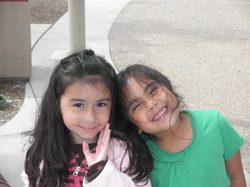
“I feel happy when...”
“It hurts my feelings when...”
“I would like to play with you.”
“Can I have a turn to use the...”
“Let’s share the...”
“Can you help me with...”
“It hurts my feelings when...”
“I would like to play with you.”
“Can I have a turn to use the...”
“Let’s share the...”
“Can you help me with...”
I advised students to remember to use a nice speaking voice, do not yell or name call, take turns to speak, do not interrupt the other person/people, have good eye contact, do not point the finger or blame the other party, and listen carefully to what they say. All together it was a lot for kindergartners to remember but I was amazed by what they were able to pick up on so quickly.
Each student took turns in small groups to be the actors in the role-plays. The rest of the class sat in the audience and would either watch and listen to see how the groups handled the fictional scenarios or give input into how to help resolve the conflict. We used both of these strategies throughout the year. As the students got more and more comfortable with the process I had to offer less and less guidance.
The real evidence of their learning came when my students realized that they could play “school” during Activity Time. Every year that I have taught, my students figured out a lot earlier that they could use the calendar and pretend to be teacher. It is usually the most popular activity. However, this group didn’t figure that out right from the beginning. It took the arrival of a new student, Anna, to start playing before any of the others asked to play.
On the very first day of playing School many conflicts happened, as they do naturally in any new situation. Kids don’t know the exact rules and don’t know what role to play in the game. I just sat back to observe how it played out. Anna jumped right into the leadership role. She assumed the job of teacher. Quickly Kristen joined and became an assistant of sorts. I have three pointers for the calendar and that only left one. BJ came running up to grab the last one. He was one of my most impulsive students and had difficulty interacting with his peers at times. He played very rough and the others didn’t always like that. I was pleasantly surprised when he used a polite speaking voice and asked, “Anna, can I use a pointer and play too?” He didn’t grab anything. He didn’t yell. It was amazing. He then joined the game smoothly. BJ asked to play with the girls perfectly. He shared, took his turn, and when he was ready to move to another activity he did. Anna and Kristen continued to play.
Quickly many more students wanted to play. Antonia seemed very excited. She was one of my students that would make her little brother be her student at home. She was used to getting to be the teacher. She was not happy when there weren’t any pointers left. She sat on the carpet in front of the calendar and moped for a few minutes. It didn’t look like she was going to take any initiative. But after some time she stood up and told the kids that were playing that she wanted to play too. The students that were already playing didn’t include her right away. They looked at her but didn’t immediately let her have a pointer. The difference here between what she did and what BJ did was very small but had a huge affect on how the other students responded. BJ asked politely to join and that he would like to use a pointer. Antonia just stated that she wanted to play but didn’t use nice words or give an example of what was needed to allow her to play. So this was when I stepped in and gave Antonia the words to use to ask Kristen and Anna to include her in their game. We practiced, asking if we could take turns using one of the pointers before asking the other girls. As soon as she did Kristen and Anna let her play. They took turns and played very nicely the rest of the afternoon.
During this process we were constantly role-playing situations. I found that to be the most important strategy for students to practice how to solve a conflict. That way they would have the skills and know what to do when a conflict would happen. I gave them fictional situations that might happen in a classroom or on the playground and asked students what they would do if it were them. These role-plays were important because they gave my students a chance to practice using the language of conflict resolution in a safe context so that when their own conflicts arose, they would have some tools and words to use to help them out.
Each student took turns in small groups to be the actors in the role-plays. The rest of the class sat in the audience and would either watch and listen to see how the groups handled the fictional scenarios or give input into how to help resolve the conflict. We used both of these strategies throughout the year. As the students got more and more comfortable with the process I had to offer less and less guidance.
The real evidence of their learning came when my students realized that they could play “school” during Activity Time. Every year that I have taught, my students figured out a lot earlier that they could use the calendar and pretend to be teacher. It is usually the most popular activity. However, this group didn’t figure that out right from the beginning. It took the arrival of a new student, Anna, to start playing before any of the others asked to play.
On the very first day of playing School many conflicts happened, as they do naturally in any new situation. Kids don’t know the exact rules and don’t know what role to play in the game. I just sat back to observe how it played out. Anna jumped right into the leadership role. She assumed the job of teacher. Quickly Kristen joined and became an assistant of sorts. I have three pointers for the calendar and that only left one. BJ came running up to grab the last one. He was one of my most impulsive students and had difficulty interacting with his peers at times. He played very rough and the others didn’t always like that. I was pleasantly surprised when he used a polite speaking voice and asked, “Anna, can I use a pointer and play too?” He didn’t grab anything. He didn’t yell. It was amazing. He then joined the game smoothly. BJ asked to play with the girls perfectly. He shared, took his turn, and when he was ready to move to another activity he did. Anna and Kristen continued to play.
Quickly many more students wanted to play. Antonia seemed very excited. She was one of my students that would make her little brother be her student at home. She was used to getting to be the teacher. She was not happy when there weren’t any pointers left. She sat on the carpet in front of the calendar and moped for a few minutes. It didn’t look like she was going to take any initiative. But after some time she stood up and told the kids that were playing that she wanted to play too. The students that were already playing didn’t include her right away. They looked at her but didn’t immediately let her have a pointer. The difference here between what she did and what BJ did was very small but had a huge affect on how the other students responded. BJ asked politely to join and that he would like to use a pointer. Antonia just stated that she wanted to play but didn’t use nice words or give an example of what was needed to allow her to play. So this was when I stepped in and gave Antonia the words to use to ask Kristen and Anna to include her in their game. We practiced, asking if we could take turns using one of the pointers before asking the other girls. As soon as she did Kristen and Anna let her play. They took turns and played very nicely the rest of the afternoon.
During this process we were constantly role-playing situations. I found that to be the most important strategy for students to practice how to solve a conflict. That way they would have the skills and know what to do when a conflict would happen. I gave them fictional situations that might happen in a classroom or on the playground and asked students what they would do if it were them. These role-plays were important because they gave my students a chance to practice using the language of conflict resolution in a safe context so that when their own conflicts arose, they would have some tools and words to use to help them out.
Demonstrating Self Advocacy and Independence
“We can do it all by ourselves.” Philip
Self advocacy can be defined as the action of representing oneself or one’s views or interests. Having independence is being free from outside control and not being dependent on another’s authority. These concepts are crucial in how they play into conflict resolution in the classroom. Students have to be able to understand and articulate their needs and wants, and then communication those to another without having to rely on a third party.
Getting students to be independent was one of the most challenging aspects of this entire process. Building their self-confidence to get them to truly believe that they had what it took to be a problem solver was a great undertaking. At times, I wondered if it was possible at all. Then, out of no-where, one of my students would say the most perfect thing and all of my doubts would vanish. Well, at least until a new one crept in.
December was the time for students to start to become data collectors. I wanted to see if my students were able to recognize when they were solving conflicts and what they did to resolve that conflict. We created a chart that hung it in classroom. They were able to mark when they had a conflict with a friend. Then, they would record if they were able to solve it independently or if they needed help from an adult. Finally they had to describe to me what they did. They ended up solving many conflicts during December and January. I was incredibly proud of my students. They took the skills they learned during our CR lessons and put them into practice. I want to highlight two moments that stood out for me. In both moments, my students were able to take control of the situation by themselves, decide what to do, and execute a positive resolution.
During Activity Time, one of the choices for students to play with during this time was a huge car track set. There are these big pieces of plastic tracks that connect together with ramps and bridges. Then the students used toy cars to zoom around on the course they built. The boys loved it! Everyday they set up an elaborate system of crazy twists and turns. The one catch was that there was only one racecar. I know, heaven forbid. I have lots of other trucks and cars but only one racecar.
One day, Chance and BJ ran to get the tracks and the racecar out of the cabinet. They grabbed the racecar at the same time and I held my breath. These are the moments that can go one of two ways: 1. they fight over the toy and someone’s feelings get hurt or 2. someone compromises. I hoped that this situation went in the way of the second option. And guess what? It did. I watched the boys on the carpet, not wanting to jump in and solve this for them. I wanted to see what they were able to do by themselves. Chance handed the racecar to BJ and said, “You can play with the racecar while I build the track. Then I can play with it after you.” My heart melted. I was so proud of Chance. He didn’t need my help at all. He saw the conflict and figured out a way to make both he and BJ happy. Hooray! I was even more shocked because this was the same little boy that only a few months earlier literally ran around the room away from Philip, not wanting to compromise over a piece of blue paper. What a difference a few months makes.
“We can do it all by ourselves.” Philip
Self advocacy can be defined as the action of representing oneself or one’s views or interests. Having independence is being free from outside control and not being dependent on another’s authority. These concepts are crucial in how they play into conflict resolution in the classroom. Students have to be able to understand and articulate their needs and wants, and then communication those to another without having to rely on a third party.
Getting students to be independent was one of the most challenging aspects of this entire process. Building their self-confidence to get them to truly believe that they had what it took to be a problem solver was a great undertaking. At times, I wondered if it was possible at all. Then, out of no-where, one of my students would say the most perfect thing and all of my doubts would vanish. Well, at least until a new one crept in.
December was the time for students to start to become data collectors. I wanted to see if my students were able to recognize when they were solving conflicts and what they did to resolve that conflict. We created a chart that hung it in classroom. They were able to mark when they had a conflict with a friend. Then, they would record if they were able to solve it independently or if they needed help from an adult. Finally they had to describe to me what they did. They ended up solving many conflicts during December and January. I was incredibly proud of my students. They took the skills they learned during our CR lessons and put them into practice. I want to highlight two moments that stood out for me. In both moments, my students were able to take control of the situation by themselves, decide what to do, and execute a positive resolution.
During Activity Time, one of the choices for students to play with during this time was a huge car track set. There are these big pieces of plastic tracks that connect together with ramps and bridges. Then the students used toy cars to zoom around on the course they built. The boys loved it! Everyday they set up an elaborate system of crazy twists and turns. The one catch was that there was only one racecar. I know, heaven forbid. I have lots of other trucks and cars but only one racecar.
One day, Chance and BJ ran to get the tracks and the racecar out of the cabinet. They grabbed the racecar at the same time and I held my breath. These are the moments that can go one of two ways: 1. they fight over the toy and someone’s feelings get hurt or 2. someone compromises. I hoped that this situation went in the way of the second option. And guess what? It did. I watched the boys on the carpet, not wanting to jump in and solve this for them. I wanted to see what they were able to do by themselves. Chance handed the racecar to BJ and said, “You can play with the racecar while I build the track. Then I can play with it after you.” My heart melted. I was so proud of Chance. He didn’t need my help at all. He saw the conflict and figured out a way to make both he and BJ happy. Hooray! I was even more shocked because this was the same little boy that only a few months earlier literally ran around the room away from Philip, not wanting to compromise over a piece of blue paper. What a difference a few months makes.
By January, my class had taken it upon themselves to make sure that there are no more conflicts about who gets to use the racecar during Activity Time. Each of the students that usually wanted to use the racecar on the tracks brought in a toy racecar from home. They kept it in their cubby and only took it out during AT. This was not something that I told them to do. They realized that if they wanted to play with a racecar and didn’t want to fight over the only one that was in the classroom they could take control and solve the problem by bringing in one from home. How impressive is that? They took the initiative to fix something that they didn’t like and then there were far few incidents surrounding the tracks.
Along with the tracks the other hot item during Activity Time were blocks. These were big wooden blocks that the class liked to use to built castles, towers, ramps, cities, etc. On this particular day Bella and Kristen were building a tower together. This was a pretty cool looking tower. There were lots of different sizes of blocks being used and Bella and Kristen looked like they were having a fun time together. After a few minutes of watching them laugh and play Maria walked over and asked to play with them. Just asking to join the game was a huge step for Maria, since she was inconsistent with her behavior towards friends. However, today she not only asked to join the girls but to top it off she asked nicely. She used a polite voice and waited for a response from Kristen and Bella. That caught my attention right away. Bella and Kristen looked at each other. I could see a little hesitation and then Kristen said, “Sure!” I was afraid they might have excluded Maria from playing but they welcomed her right into their tower-making extravaganza. The three of them sat together all Activity Time and played harmoniously. This interaction could have gone very badly. If Kristen had said no, then Maria would have had her feelings hurt and probably would have retaliated in some way. But because she was included in the game we had a very peaceful afternoon.
Along with the tracks the other hot item during Activity Time were blocks. These were big wooden blocks that the class liked to use to built castles, towers, ramps, cities, etc. On this particular day Bella and Kristen were building a tower together. This was a pretty cool looking tower. There were lots of different sizes of blocks being used and Bella and Kristen looked like they were having a fun time together. After a few minutes of watching them laugh and play Maria walked over and asked to play with them. Just asking to join the game was a huge step for Maria, since she was inconsistent with her behavior towards friends. However, today she not only asked to join the girls but to top it off she asked nicely. She used a polite voice and waited for a response from Kristen and Bella. That caught my attention right away. Bella and Kristen looked at each other. I could see a little hesitation and then Kristen said, “Sure!” I was afraid they might have excluded Maria from playing but they welcomed her right into their tower-making extravaganza. The three of them sat together all Activity Time and played harmoniously. This interaction could have gone very badly. If Kristen had said no, then Maria would have had her feelings hurt and probably would have retaliated in some way. But because she was included in the game we had a very peaceful afternoon.
During December and January students recorded 46 total conflicts. Students were able to solve 27 conflicts independently and 19 conflicts needed some help to be solved. These were not all of the conflicts that happened. The students did not record some but I think that it was a good representation of some of the problems that occurred in the classroom. The conflicts came up at all times of the day and in many different ways. Most of the conflicts had to do with playing, whether it was at recess or Activity Time. Students were either not sharing, excluding others, or not taking turns.
During the two months that we were recording conflicts in the classroom I noticed that the types of conflicts didn’t change very much. Most conflicts emerged during recess and Activity Time and usually fell into one of 4 categories:
1.Excluding a Friend
2.Calling a Friend a Name
3.Touching a Friend
4.Not sharing with a Friend
It was an interesting process to record their conflicts because the recordings came in chunks. When one student added a conflict to the chart immediately three more students said they needed to record a conflict that was solved. At times, it was difficult to tell which conflicts were genuine and when students just wanted to put something on the chart. I think this would be a great thing for teachers to keep track of with students in higher grades. It might be easier to gather data that isn’t as skewed because older students will have a better understanding. Regardless, my students enjoyed being researchers. They felt like part of the process and as BJ said, it was “so cool” to help me with my homework.
During the two months that we were recording conflicts in the classroom I noticed that the types of conflicts didn’t change very much. Most conflicts emerged during recess and Activity Time and usually fell into one of 4 categories:
1.Excluding a Friend
2.Calling a Friend a Name
3.Touching a Friend
4.Not sharing with a Friend
It was an interesting process to record their conflicts because the recordings came in chunks. When one student added a conflict to the chart immediately three more students said they needed to record a conflict that was solved. At times, it was difficult to tell which conflicts were genuine and when students just wanted to put something on the chart. I think this would be a great thing for teachers to keep track of with students in higher grades. It might be easier to gather data that isn’t as skewed because older students will have a better understanding. Regardless, my students enjoyed being researchers. They felt like part of the process and as BJ said, it was “so cool” to help me with my homework.
Reviewing Skills Learned
“I remember what to do.” Nick
February was a challenging month at LdV. We were in the process of finding a new location for the next year. There was a lot of stress in the air about the financial soundness of the school. All the parents and teachers were running around trying to figure out what our status was going to be. The tension was noticeable and the kids picked up on it. I thought at first that it might have been the weather and it was in a way. It was the climate of our school. They knew something was going on that they didn’t understand it or have control over.
I saw more conflicts and heard more tattling during this month than all year combined. They couldn’t work together. They wouldn’t listen to each other. Everyone seemed to respond with “I’m telling.” I was shocked. I couldn’t believe what was happening. After all the months of us practicing our CR skills and building a peaceful community, all I could think was, “Oh my goodness, what has happened? What can I do to fix this?”
I came up with a plan to get us back on track. Every morning beginning in the last week of February we held a class meeting. We sat in a circle and gave ourselves one goal for the day. We wanted to practice being good friends, not tattling, using our words when we have conflicts, being respectful, and listening to each other when someone was talking. Then at the end of the day we would revisit our goal from the morning and evaluate how we did. I told the class what I saw and heard and I gave them a chance to tell me what they did or noticed during the day.
After two weeks of craziness from my students we needed this time to regroup and review all the things we have been practicing. It seemed to work. This week went much better. They started to get back onto the previous path. I heard students using problem-solving language again. For example Hugo told Nick that he would help him clean up the Legos, even though Hugo didn’t play with them. Adrian showed Maddie how to get onto starfall.com. Arianna wasn’t running up to me and tattling on Philip and telling me what he was doing every ten minutes, because it had gotten to that point. Kristen was sharing toys with her friends. Maria wasn’t glaring at others as often. I hoped things would continue to get back on track.
I found that it was important to keep practicing conflict resolution, especially during difficult times. That was when my students needed the most support. Our daily goals and class meetings helped us get the feel of the peaceful community back.
At this point in the school year we were not actively recording conflicts any longer but CR is something that needs constant revisiting and practice. Just because my AR project was coming to an end didn’t mean that we were dropping it altogether.
In the beginning of March we began learning about the farm. I read many versions of The Little Red Hen. We thought it would be fun to have small groups create and perform their own version of the story. Here was my class’ opportunity to show me if they were able to communicate and collaborate to create their own reenactment. I put them into groups of 6 or 7 and only gave a few stipulations: Each group had to have a Little Red Hen and each person needed to be a different animal (no doubles within the group). Before I sent them on their way we reviewed some strategies for solving conflicts just in case. I walked around the room but did not facilitate any of the groups. They had to communicate with each other. At first I could see certain students looking to me to help but after a few minutes each group was deep in conversation about the characters and the story they wanted to create.
As I walked around the classroom I started to hear voices raising from one of the groups. Adrian and Arianna both wanted to be the Little Red Hen. Adrian suggested that they do Paper, Rock, Scissors. Arianna agreed that that would be the best way to decide who got to be the main character. Adrian won and became the Little Red Hen. Arianna then said that she wanted to be a butterfly. Antonia jumped up and said that she also wanted to be the butterfly. It looked as if there was going to be an argument between the girls over who got to be the butterfly. Then Antonia looked at Arianna and said, “Since you don’t get to be the Little Red Hen, you be the butterfly. I’ll be a ladybug.” I was so proud of Adrian, Arianna, and Antonia. They were all able to work together to form a group of different characters without having any conflict get out of hand. They solved two problems before they escalated into something major.
The power of revisiting concepts learned and reviewing strategies was something that I found to be one of the most beneficial things for my class. They became successful at identifying and solving conflicts, but only because it was a natural part of our class culture to review them.
“I remember what to do.” Nick
February was a challenging month at LdV. We were in the process of finding a new location for the next year. There was a lot of stress in the air about the financial soundness of the school. All the parents and teachers were running around trying to figure out what our status was going to be. The tension was noticeable and the kids picked up on it. I thought at first that it might have been the weather and it was in a way. It was the climate of our school. They knew something was going on that they didn’t understand it or have control over.
I saw more conflicts and heard more tattling during this month than all year combined. They couldn’t work together. They wouldn’t listen to each other. Everyone seemed to respond with “I’m telling.” I was shocked. I couldn’t believe what was happening. After all the months of us practicing our CR skills and building a peaceful community, all I could think was, “Oh my goodness, what has happened? What can I do to fix this?”
I came up with a plan to get us back on track. Every morning beginning in the last week of February we held a class meeting. We sat in a circle and gave ourselves one goal for the day. We wanted to practice being good friends, not tattling, using our words when we have conflicts, being respectful, and listening to each other when someone was talking. Then at the end of the day we would revisit our goal from the morning and evaluate how we did. I told the class what I saw and heard and I gave them a chance to tell me what they did or noticed during the day.
After two weeks of craziness from my students we needed this time to regroup and review all the things we have been practicing. It seemed to work. This week went much better. They started to get back onto the previous path. I heard students using problem-solving language again. For example Hugo told Nick that he would help him clean up the Legos, even though Hugo didn’t play with them. Adrian showed Maddie how to get onto starfall.com. Arianna wasn’t running up to me and tattling on Philip and telling me what he was doing every ten minutes, because it had gotten to that point. Kristen was sharing toys with her friends. Maria wasn’t glaring at others as often. I hoped things would continue to get back on track.
I found that it was important to keep practicing conflict resolution, especially during difficult times. That was when my students needed the most support. Our daily goals and class meetings helped us get the feel of the peaceful community back.
At this point in the school year we were not actively recording conflicts any longer but CR is something that needs constant revisiting and practice. Just because my AR project was coming to an end didn’t mean that we were dropping it altogether.
In the beginning of March we began learning about the farm. I read many versions of The Little Red Hen. We thought it would be fun to have small groups create and perform their own version of the story. Here was my class’ opportunity to show me if they were able to communicate and collaborate to create their own reenactment. I put them into groups of 6 or 7 and only gave a few stipulations: Each group had to have a Little Red Hen and each person needed to be a different animal (no doubles within the group). Before I sent them on their way we reviewed some strategies for solving conflicts just in case. I walked around the room but did not facilitate any of the groups. They had to communicate with each other. At first I could see certain students looking to me to help but after a few minutes each group was deep in conversation about the characters and the story they wanted to create.
As I walked around the classroom I started to hear voices raising from one of the groups. Adrian and Arianna both wanted to be the Little Red Hen. Adrian suggested that they do Paper, Rock, Scissors. Arianna agreed that that would be the best way to decide who got to be the main character. Adrian won and became the Little Red Hen. Arianna then said that she wanted to be a butterfly. Antonia jumped up and said that she also wanted to be the butterfly. It looked as if there was going to be an argument between the girls over who got to be the butterfly. Then Antonia looked at Arianna and said, “Since you don’t get to be the Little Red Hen, you be the butterfly. I’ll be a ladybug.” I was so proud of Adrian, Arianna, and Antonia. They were all able to work together to form a group of different characters without having any conflict get out of hand. They solved two problems before they escalated into something major.
The power of revisiting concepts learned and reviewing strategies was something that I found to be one of the most beneficial things for my class. They became successful at identifying and solving conflicts, but only because it was a natural part of our class culture to review them.
